Last updated: March 30, 2023
Article
Going-to-the-Sun Road: A Model of Landscape Engineering (Teaching with Historic Places)
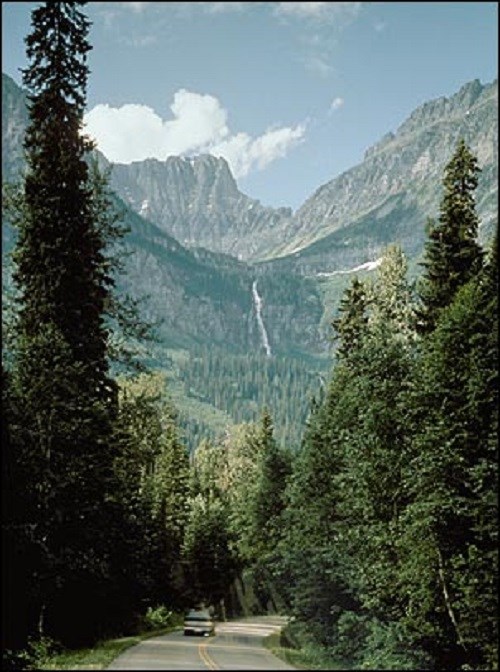
(Historic American Engineering Record, Martin Stupich, photographer)
Soaring mountain peaks, glaciers, deep-blue lakes, and lush forests of spruce, lodgepole pine, cedar, hemlock, and subalpine fir delight the senses of visitors who drive on Going-to-the-Sun Road through Glacier National Park in northwestern Montana. Turnouts allow visitors to relish vistas of glacier-sculpted mountains and glimpse wildlife.
Before this east-west road was constructed, only a small number of people could enjoy this spectacular scenery. The construction of the Going-to-the-Sun Road, dedicated in 1933, made this splendid experience available to the hundreds of thousands of visitors who come to the park by car. Building this transmountain road, which was literally carved out of the precipitous mountainside for 12 of its 50-mile length, was a challenging and dangerous task. Its designers and builders learned valuable lessons that were applied to many such scenic roads to follow.
About This Lesson
This lesson is based on the National Historic Landmark documentation form "Going-to-the-Sun Road, Glacier National Park, Montana" (with photographs); the National Register of Historic Places Multiple Property Documentation form, "Historic Park Landscapes in National and State Parks"; and archival material. Fay Metcalf, an education consultant, wrote Going-to-the-Sun Road. Marilyn Harper and the Teaching with Historic Places staff edited the lesson. TwHP is sponsored, in part, by the Cultural Resources Training Initiative and Parks as Classrooms programs of the National Park Service. This lesson is one in a series that brings the important stories of historic places into classrooms across the country.
Where it fits into the curriculum
Topics: The lesson may be used in American history, social studies, and geography courses in units on conservation and the environment or the influence of the automobile on popular culture.
Time period: 1920s and 1930s
United States History Standards for Grades 5-12
Going-to-the-Sun Road: A Model of Landscape Engineering relates to the following National Standards for History:
Era 6: The Development of the Industrial United States (1870-1900)
-
Standard 1D- The student understands the effects of rapid industrialization on the environment and the emergence of the first conservation movement.
Curriculum Standards for Social Studies
(National Council for the Social Studies)
Going-to-the-Sun Road: A Model of Landscape Engineering relates to the following Social Studies Standards:
Theme I: Culture
-
Standard A - The student compares similarities and differences in the ways groups, societies, and cultures meet human needs and concerns.
Theme II: Time, Continuity and Change
-
Standard A - The student demonstrates an understanding that different scholars may describes the same event or situation in different ways but must provide reasons or evidence for their views.
-
Standard C - The student identifies and describes selected historical periods and patterns of change within and across cultures, such as the rise of civilizations, the development of transportation systems, the growth and breakdown of colonial systems, and others.
-
Standard E - The student develops critical sensitivities such as empathy and skepticism regarding attitudes, values, and behaviors of people in different historical contexts.
-
Standard F - The student uses knowledge of facts and concepts drawn from history, along with methods of historical inquiry, to inform decision-making about and action-taking on public issues.
Theme III: People, Places and Environments
-
Standard A - The student elaborates mental maps of locales, regions, and the world that demonstrate understanding of relative location, direction, size, and shape.
-
Standard B - The student creates, interprets, uses, and distinguishes various representations of the earth, such as maps, globes, and photographs.
-
Standard C - The student uses appropriate resources, data sources, and geographic tools such as aerial photographs, satellite images, geographic information systems (GIS), map projections, and cartography to generate, manipulate, and interprets information such as atlases, data bases, grid systems, charts, graphs, and maps.
-
Standard E - The student locates and describes varying land forms and geographic features, such as mountains, plateaus, islands, rain forests, deserts, and oceans, and explain their relationships within the ecosystem.
Theme V: Individuals, Groups, and Institutions
-
Standard G - The student applies knowledge of how groups and institutions work to meet individual needs and promote the common good.
Theme VI: Power, Authority and Governance
-
Standard C - The student analyzes and explains ideas and governmental mechanisms to meet wants and needs of citizens, regulate territory, manage conflict, and establish order and security.
Theme X: Civic Ideals and Practices
-
Standard C - The student locate, access, analyze, organize, and apply information about selected public issues recognizing and explaining multiple points of view.
-
Standard D - The student practice forms of civic discussion and participation consistent with the ideals of citizens in a democratic republic.
-
Standard E - The student explain and analyze various forms of citizen action that influence public policy decisions.
-
Standard J - The student examine strategies designed to strengthen the "common good," which consider a range of options for citizen action.
Objectives for students
1) To identify the problems encountered in designing and building Going-to-the-Sun Road.
2) To analyze the role of Frank A. Kittredge in planning Going-to-the-Sun Road.
3) To describe and evaluate arguments for building roads to provide access to Glacier National Park and other backcountry and wilderness regions.
4) To identify an important highway or parkway in their own community and describe the work that went into its construction.
Materials for students
The materials listed below either can be used directly on the computer or can be printed out, photocopied, and distributed to students. The maps and images appear twice: in a smaller, low-resolution version with associated questions and alone in a larger version.
1) two maps showing Montana and Glacier National Park;
2) three readings about building Going-to-the-Sun Road and National Park Service policy on conserving the landscape;
3) six photographs showing the construction of the road and scenic vistas from it;
4) one drawing of Going-to-the-Sun Road.
Visiting the site
Glacier National Park is a unit of the National Park Service. To travel on Going-to-the-Sun Road, enter the park from the west by taking U.S. Highway 2 to the West Glacier entrance. From the east, go north from the junction of U.S. Highway 2 on the Blackfeet Highway (U.S. 89) to St. Mary. Visitor centers are located in Apgar, Logan Pass, and St. Mary. For more information, contact Glacier National Park, West Glacier, MT 59936 or visit the Park's Web page.
Getting Started
Inquiry Question
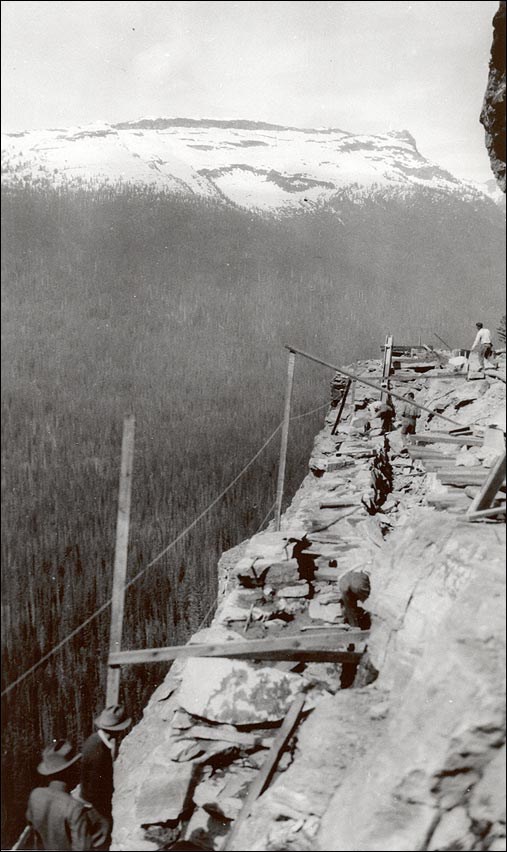
What appears to be taking place in this photo?
Setting the Stage
The automobile revolutionized America's great national parks in the 1920s and 30s. As the number of private cars rose, the number of visitors driving to parks and other scenic attractions also increased. Even before the creation of the National Park Service in 1916, many visitors to Montana's Glacier National Park and the other 13 existing national parks arrived by car. Without adequate roads or accommodations, these tourists risked damaging the scenic landscapes they had come to enjoy.
Stephen Mather, the first director of the National Park Service, knew that allowing the public to enjoy spectacular park landscapes would create support for protecting the parks from grazing, logging, and water projects. These visitors also would bring a "great flow of tourist gold" into areas near the parks. Sharing Mather's vision, local boosters, elected officials, and automobile clubs began to seek congressional funding for improved park roads.
Going-to-the-Sun Road was the first to carry visitors by the lakes, glaciers, alpine peaks, and meadows of Glacier National Park. The 50-mile route, which connected the east and west sides of the park and crossed the Continental Divide at Logan Pass, was surveyed in 1918, and work began in 1921. Progress was slow, however, due to limited and erratic congressional funding and the difficulties of working under extreme mountainous conditions.
In 1924, Congress appropriated a million dollars for building the transmountain highway at Glacier. Much of the planning and construction was done in cooperation with the Bureau of Public Roads (later the Federal Highway Administration). The Bureau's high technical standards needed to be balanced against the commitment of the National Park Service to damage the landscape as little as possible. Going-to-the-Sun Road was a challenge for both partners and provided a model for subsequent roads in national and, eventually, state parks for more than 25 years.
Locating the Site
Map 1: Montana.
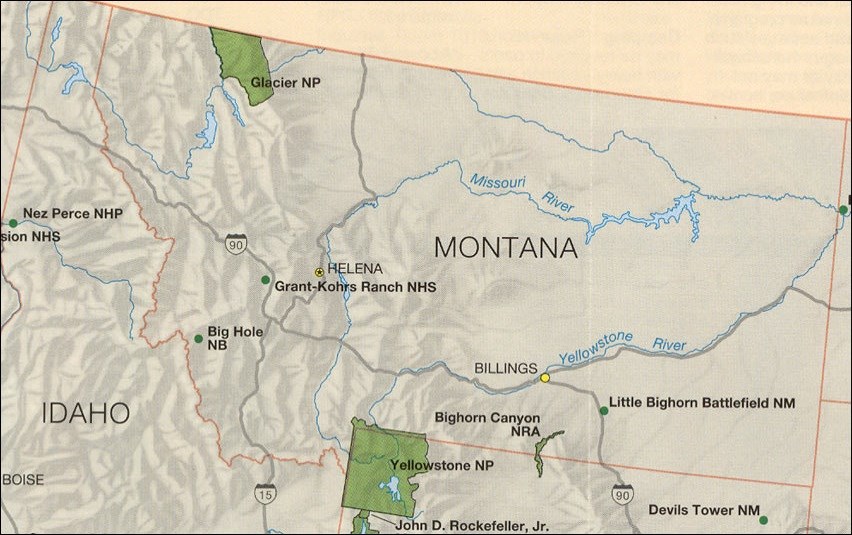
National Park Service
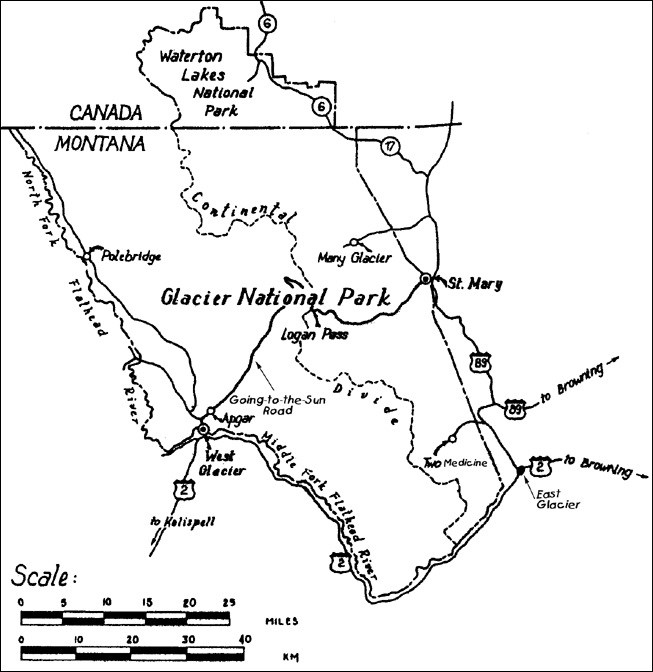
(Historic American Buildings Survey/Historic American Engineering Record)
Glacier National Park, which includes over one million acres of Rocky Mountain scenery, was designated as the country's 10th national park in 1910. The Great Northern Railway soon began building a series of hotels and chalets throughout the park. Early visitors typically arrived by train at East Glacier or West Glacier. They journeyed through the mountains each day on horseback and stayed at a different hotel or chalet at night. The completion of Going-to-the-Sun Road in the early 1930s made it much easier for visitors to experience the awesome scenery of the park itself and for motorists from the eastern and western United States to enter the park. Even today, the only other roads in the park are short access roads to hotels, visitor centers, campgrounds, and trails.
Questions for Maps 1 and 2
1. Locate Glacier National Park on Map 1. How would you describe its location? How might the location of the park and the lack of roads through the park have impacted early visitation?
2. How did most visitors experience Glacier National Park in the early 20th century?
3. Today the vast majority of visitors arrive by car. Almost all drive on Going-to-the-Sun Road, the only road crossing the park. What would be some of the advantages and disadvantages of having only one major road through such a large park?
4. Trace the route of Going-to-the-Sun Road on Map 2. Suggest some reasons why the route curves.
Determining the Facts
Reading 1: Surveying Going-to-the-Sun Road
In 1924 Stephen T. Mather, Director of the National Park Service, asked the Bureau of Public Roads for help in designing and constructing the central and most difficult part of the transmountain road through Glacier Park. One of the bureau's highway engineers, Frank Kittredge, was asked to survey a possible route crossing the Continental Divide at Logan Pass. In the reading that follows, Kittredge remembers his seven weeks' work:
On a beautiful fall day (September 16, 1924) Superintendent [of Glacier National Park] Charles Kraebel drove me to the beginning of the proposed operations--along the shores of beautiful Lake McDonald fringed with dense forests of evergreens interspersed with the stately tamarac and clusters of already coloring quaken aspen; thence along McDonald Creek with its falls and tumbling white water as it cascaded through the canyon. And rounding a bend in the road there, squarely across the canyon, stood the great wall, the backbone of the Continental Divide, here called "The Garden Wall."
Schooled in the engineering practicality of things and in the planning and building, nevertheless, this park and this job seemed to me to be the culmination. This great project in Glacier Park seemed to develop more of the exuberance and the challenge of conquest, of pioneering with nature. And how fortunate I was to be here in this, one of the choicest, wildest, and most beautiful areas, and incidentally to be paid for being part of it.
But with the thrill of the country and the job, there was the feeling of awe and humility over the great responsibility of searching out, surveying and recommending the route which would mar the least the stupendous beauty of the Garden Wall, the mountains and the canyons while making available to people the most and best of Nature's creation. How to carry into the roadbuilding these great intangible values for the inspiration of people without sacrificing the very values we came for was the problem of the engineer.
The task was a little bit terrifying, inasmuch as it was already fall and winter closes in very early in this high altitude and far northern climate. But the elements were with us for the first two weeks and during the early reconnaissance period.
[Based on the reconnaissance] the present route following the Garden Wall over cliffs, along rock ledges, across deep canyons, was determined upon. The cost obviously would be heavy but there appeared to be no other route which would adequately show to the public the tremendous spectacle of mountains and canyons, forests and streams, and no other route which would be capable of improvement of alignment and width of roadway if and when traffic should require improvement.
The reconnaissance having been completed, the decision made as to route, the two camps established, and thirty-two men employed, we were then ready to undertake the labors of survey.
At the beginning of the survey every man not only had to walk several miles to work but also had to climb about 2,700 feet vertically every morning before starting the actual work. This would be equivalent to climbing the Washington Monument [987 steps] five times before getting down to the job at hand every morning. If it happened to be snowy or wet with no good footing and perhaps slipping back or falling down every now and then, it was equivalent in fatigue to several more climbs of the Monument. And then the walking along and clinging to the steep mountainside was not easy for anyone and extremely difficult and dangerous for some. Having to cut one's way with axes through brush and make one's way along cliffs, as the case might be, was an undertaking to put even the mountain sheep to shame.
The engineering crew was working along these same cliffs and the resident engineer appealed to his chief for an increase in pay for his assistants because of the unusual hardships and dangers of the job. The reply was no, that engineers were supposed to be hardy and to be able to take the dangers of such jobs. A few weeks later, this man made an inspection of the project and was taken over the cleared survey trail. At one point, the resident engineer walked along the cliff path as was his custom, but his chief cried out for help. Upon turning around, the resident engineer observed his boss clinging to the wall, knees trembling (and I know from personal experience how that feels), and in fear of falling. This seemed like a psychological opportunity, so the resident engineer--while steadying his chief--quietly remarked, "How about that raise for the boys?" The response from the boss--grand man that he was--was quick and effective, "Give them anything you want." ...However, in order to keep thirty-two men on the job continuously, 135 were employed during [the seven week survey] period.
The survey proceeded regardless of rain, sunshine, or snow--within limits, until early November when four feet of snow fell on the east side of Logan Pass and enough on the west side to severely handicap the work.... We had made the survey and obtained the necessary data for preparing the plans and specifications for a spring [road building contract]....
Questions for Reading 1
1. How did the survey crew get to work?
2. What were some of the conditions that made this survey difficult and dangerous?
3. How did the resident engineer manage raises for his workers?
4. What factors did Kittredge take into consideration in selecting the route?
5. Do you think he enjoyed his survey work at Glacier National Park? Why or why not?
Reading 1 was excerpted from Frank A. Kittredge, "The Survey of the Going-to-the-Sun Highway," Driver's Manual, eighth ed. (Glacier Park Transport Co., 1949), 85-89.
Determining the Facts
Reading 2: Building Going-to-the-Sun Road
The eastern and western sections of Going-to-the-Sun Road had been completed before Kittredge's survey of the central and most difficult portion. Even after the final route was chosen, it took eight more years to complete construction.
The story of building the section of the road through the extreme terrain and conditions west of Logan Pass illustrates why construction took so long. Because work on all parts of the road progressed at the same time, workers did not have a completed road below them to transport their supplies. The contractors relied on about 15 miles of construction trails and a crude road to haul supplies around incomplete sections of the road. The west side tunnel was a major obstacle. To get around the tunnel area, the contractors sent their supplies up an existing hiking trail. They then built a rough road downhill. They built a cabin to store supplies and even parked a steam shovel there during the winter of 1925-1926.
Most of the 12-mile central section was constructed with the aid of three power shovels--two steam shovels and one gas shovel. The contractors also used pneumatic drills and almost 500,000 pounds of explosives. Construction typically took place in stages. First, the engineering crew marked the way followed by laborers who cut down the trees and did the "grubbing," removing stumps and roots. Then the explosives men moved in. After the explosion broke up the rock, the power shovels cleared and loaded the debris on trucks or on "dinky" railroads. These little trains, powered by small gas locomotives, generally had about 12 dump cars and ran on tracks several hundred feet long to dump the rock in a designated location. Once the rock debris was removed, the remaining rock bed was essentially complete except for surfacing and any necessary masonry work.
Most of the masonry work--bridges, culverts, retaining walls, and guardrails--was done by subcontracting "station gangs." Typically, these were groups of eight to ten men whose efforts were particularly useful in places the power shovels could not be used--especially along the Garden Wall. Laborers came from all over. One group of Russian immigrants set up their own cook tent with their own cook. A number of Italian immigrants worked on the masonry guardrails. One Irish-American contractor tended to hire his fellow Irish from Butte, Montana.
Animals were sometimes a problem. One account describes a deer that became entangled in blasting wires and prevented a blast that would have killed it. There were many stories about the bears that were drawn to the camps by the smell of food. Employees had to watch their lunches; they would hang them in trees along with saws or other tools that would move with the wind and frighten off the bears. At food supply stations contractors would pound nails in the walls with the points outward. One meathouse was built on stilts and fitted out with a drawbridge. One black bear even set up a permanent post at the back door of a camp kitchen. Grizzly bears were far more dangerous than black bears and caused serious alarm. When one threatened the Russian crew at Camp 6 on Logan Pass, the contractors called in park rangers for protection.
Three men died during construction of the road. One man was hanging from a rope to check the safety of an overhanging rock and slipped and fell to the roadbed. Another man was hit on the head by a rock; the third man was killed in a rockslide.
When the road was ready for traffic in 1933, the Park Service prepared a dedication ceremony. Both Congressman Louis C. Cramton and Park Naturalist George C. Ruhle are credited with coming up with the name "Going-to-the-Sun Road," borrowed from nearby Going-to-the-Sun Mountain. The park superintendent, J. R. Eakin, liked the name because "it gives the impression that in driving this road autoists will ascend to extreme heights and view sublime panoramas." Visitors ever since have agreed.
Questions for Reading 2
1. How many years did it take to construct the central portion of the road? Why was this section the most difficult?
2. How did the road contractors get supplies to the highest sections of the project?
3. What stages did the road construction go through?
4. Who made up the labor force?
5. What were some of the dangers workers on the road encountered?
6. Why did the park superintendent like the name "Going-to-the-Sun Road"? Do you think it was a good choice?
Reading 2 was compiled from Kathryn Steen, "Going-to-the-Sun Road," (HAER No. MT-67), Washington, D.C.: U.S. Department of the Interior, National Park Service, Historic American Engineering Record, 1990, 1, 23-32; and "Through the Years in Glacier National Park" (Glacier Natural History Association, 1960).
Determining the Facts
Reading 3: Preserving the Landscape
Roads in parks were not simply engineering projects, they were also works of "landscape engineering." This concept was rooted in fundamental National Park Service policies: first, that the landscape be preserved, and, second, that all necessary construction harmonize with nature. The Glacier highway project helped define the role of Park Service landscape engineers. "Landscape protection" needed to be central to the fundamental civil engineering decisions that now loomed large in plans for development at Glacier and at many other parks.
The section of the route for the Going-to-the-Sun Road over the Continental Divide was the first test. In 1918, National Park Service Chief Engineer George Goodwin proposed a route that followed the Logan Creek Valley, ascending about 2,600 feet to Logan Pass. The proposed route crossed Logan Creek seven times in a series of hairpin turns, or switchbacks, ascending the steep slope. Goodwin claimed that this direct route would "meet every requirement for park travel or commercial hauling"--requirements that he assumed were more or less identical.1
Stephen Mather, Director of the National Park Service, went to Glacier during the summer of 1924 to inspect the proposed route with Goodwin, Park Service landscape engineer Thomas Vint, and the park superintendent. Dismounting a few miles west of Logan Pass, the group took in the view of Logan Creek and the summits of the Livingston Range that marked the Continental Divide down the center of the park. Dominated by the huge, almost vertical cliff called the Garden Wall, the green valley of Logan Creek provided the foreground of a stunning panorama of the Glacier high country. Thomas Vint complained that building switchbacks up the valley would make it look "like miners had been in there." Instead, he urged the director to replace the series of switchbacks with a road carved directly into the rock of the Garden Wall. This relatively straight roadway would preserve the valley below completely untouched. The solution called for a much longer road benched into solid rock for many miles. Although more challenging and expensive, it resulted in a simple and elegant design.
Mather faced an important choice. Considering the dramatic views from the approaches to Logan Pass, there were expectations that the Glacier road would be the most spectacular scenic drive in the country. But the potential for failure was great. If the road permanently scarred the scenic heart of Glacier National Park, or if the project was merely bungled through bad management, the reputation of the Park Service might never recover. Two days later, Mather enlisted the aid of the Bureau of Public Roads, a federal agency whose high standards of highway construction he admired. The Bureau assigned Frank Kittredge to survey the route.
In his 1925 report to the Park Service, Kittredge presented three alternatives. Goodwin's 1918 proposal was the first; the second was a revised version of the 1918 proposal. The third alternative was the Garden Wall route that Vint had suggested the previous summer. Kittredge "strongly recommended" this alternative, since it "met the requirements more than any other." The route would "permit safe grades and curvature," would be "capable of future improvement," and could be kept free of snow for the longest possible season. Beside these practical considerations, the engineer added that the third alternative would "exhibit the grandeur of the park to the maximum."2 In Kittredge, Vint had found an ally who could validate landscape preservation not only as good policy, but also as good engineering.
In April, representatives of the Park Service and the Bureau of Public Roads met to lay out the ground rules for how the Service and the Bureau would cooperate on Going-to-the-Sun Road. The interbureau arrangement allowed the Park Service to take advantage of the expertise and organization of the Bureau of Public Roads without giving up control over where, when, and how park roads would be built. Park Service landscape engineers retained the right to review and alter location surveys and contract specification to assure that construction met their standards for landscape preservation, as well as the Bureau standards for sound and economical engineering. In January 1926, these arrangements were formalized in a memorandum of agreement between the National Park Service and the Bureau of Public Roads that defined park road projects for the next 25 years.3
The construction of the western portion of the Going-to-the-Sun Road guided the evolution of the interbureau arrangement. The construction contracts had been written to prohibit blasting that would scar trees over a wide area. Excavated materials were to be thrown over the side of the road only in areas where roadsides and trees were less likely to be damaged. Both clauses were sometimes ignored. In one case, the blasting crew packed 12 and a half tons of black powder and 80 boxes of dynamite into a series of large holes. When the charge was ignited, an eyewitness reported that he "saw, or had the impression of seeing...what looked to be a half of a mountain slowly rise, crumble, move out, and drop over a cliff...[leaving] a horrendous scar on the mountainside."4 Only after Kittredge became chief engineer of the Park Service in 1927 was he able to ensure enforcement of provisions intended to protect surrounding landscape features, even at the cost of convenience and economy.
Park Service commitment to "preserve the landscape" at any cost and the high construction standards of the Bureau of Public Roads greatly increased the expense of building the road. When Going-to-the-Sun Road was finally dedicated in 1933, it had been eight years since Kittredge re-surveyed the western approach to Logan Pass, and 11 since the first Congressional appropriations. The road that Goodwin had estimated at about $600,000 had cost over $2,500,000. But it was, according to Superintendent Scoyen, "the most beautiful piece of mountain road in the world." And the road had helped inspire a policy for roads in other parks, as the letter from National Park Service Director Albright that Scoyen read at the dedication made clear: "The major portion of Glacier Park will always be accessible only by trail....Let there be no competition of other roads with the Going-to-the-Sun [Road]. It should stand supreme and alone."5
Questions for Reading 3
1. What were the alternate proposals for the route over Logan Pass? How did they differ?
2. Why was the Garden Wall route selected?
3. One historian of Park Service landscape design said that "finalizing the location of the route over Logan Pass presented the most important single road-building decision yet faced by Mather and the Park Service." Why do you think he might have thought so?
4. Look again at the quote from Director Albright. What do you think the new park policy on road building in the parks was?
Reading 3 was adapted from Ethan Carr, "Going-to-the-Sun Road" (Glacier and Flathead County, Montana) National Historic Landmark documentation, Washington, D.C.: U.S. Department of the Interior, National Park Service, 1996; and Kathryn Steen, "Going-to-the-Sun Road" brochure, Washington, D.C.: U.S. Department of the Interior, National Park Service, n.d.
1 George Goodwin to A. J. Breitenstein, August 17, 1921, Glacier National Park, Central Files, Entry 6, RG 79, National Archives, Washington, D.C.
2 Frank A. Kittredge, "Trans-Mountain Highway, Glacier National Park, Report to National Park Service," February 5, 1925, 1-3, 9-10, 22. Glacier National Park, Central Files, Entry 6, RG 79, National Archives, Washington, D.C.
3 "Memorandum of Agreement Between the National Park Service and the Bureau of Public Roads Relating to the Survey, Construction, and Improvement of Roads and Trails in the National Parks and National Monuments," January 18, 1926, Papers of Horace M. Albright, Entry 17, RG 79, National Archives, Washington, D.C.
4 Gordon L. Harrison, "Looking Back on the Sun Road," c. 1989, p. 67. Unidentified article in Glacier Park Library.
5 Horace M. Albright, "Memorandum for the Secretary," re: Glacier ceremonies, July 17, 1933, Glacier National Park, General File, RG 48, National Archives, Washington, D.C.
Visual Evidence
Drawing 1: Going-to-the-Sun Road.
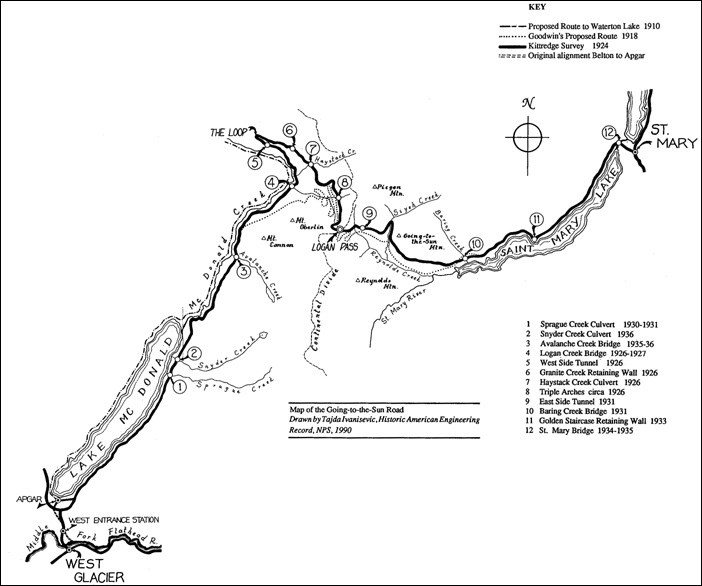
(Historic American Engineering Record)
This map shows both the route proposed by George Goodwin and the one by Thomas Vint, which was surveyed by Frank Kittredge. Goodwin's proposal covered areas which were extremely steep. It included grades up to 8% and required many switchbacks, some with a turning radius of only 50 feet. Vint's plan had fewer switchbacks, a maximum grade of 6%, and a turning radius of no less than one hundred feet. Today's interstate highways usually allow only a 3 to 4% grade and a minimum 150 foot radius for curves. The portion of the road between the Loop and Logan Pass runs along the Garden Wall.
Questions for Drawing 1
1. Compare Goodwin's and Vint's proposed routes. What are the most obvious differences? Why would Vint's proposal be better for tourists driving the road?
2. Why do you think the National Park Service selected Vint's proposal? (Refer to reading 3 if necessary.)
3. What is missing from the drawing that would give you a better sense of the difficulties involved in constructing this road?
Visual Evidence
Photo 1: Glacier National Park, area near Logan Pass, ca. 1930.
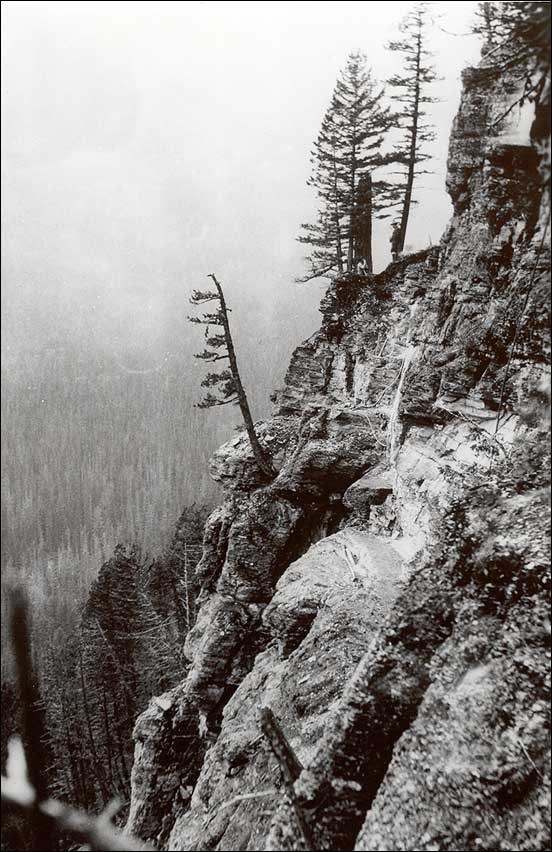
National Park Service.

National Park Service
Questions for Photos 1 and 2
1. Photo 1 shows what the area that Frank Kittredge was surveying looked like. How does this view compare with what you expected based on the information you have learned so far?
2. What questions would you ask and what kinds of information do you think you would need to make decisions about where to build a road in an area like this?
3. Locate the stone retaining wall shown in Photo 2 on Drawing 1. Half of the roadway is cut into the rock, the other half is supported by the bridge. The decision to build Going-to-the-Sun Road along the Garden Wall made this kind of construction necessary. Why do you think this route was more expensive to build than the route proposed by Goodwin?
Visual Evidence
Photo 3: Triple Arches.
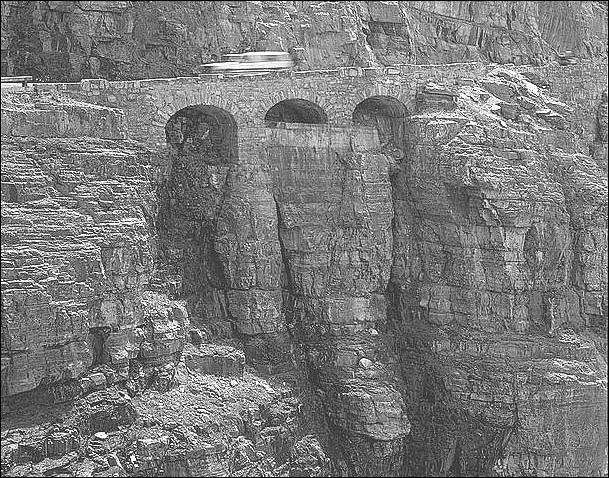
Find this bridge on Drawing 1. It supports the outer edge of the road in an area where there are deep cracks in the rock of the Garden Wall.
Questions for Photo 3
1. In 1918, the National Park Service stated that, "in the construction of roads, . . . particular attention must be devoted always to the harmonizing of these improvements with the landscape." How does this bridge attempt to do that? Do you think it succeeds? Do you agree with the Park Service policy?
2. The photo shows a car moving quickly across the bridge. Do you think the driver would be aware that he was crossing a bridge?
Visual Evidence
Photo 4: Construction equipment near Going-to-the-Sun Mountain, ca. 1932.
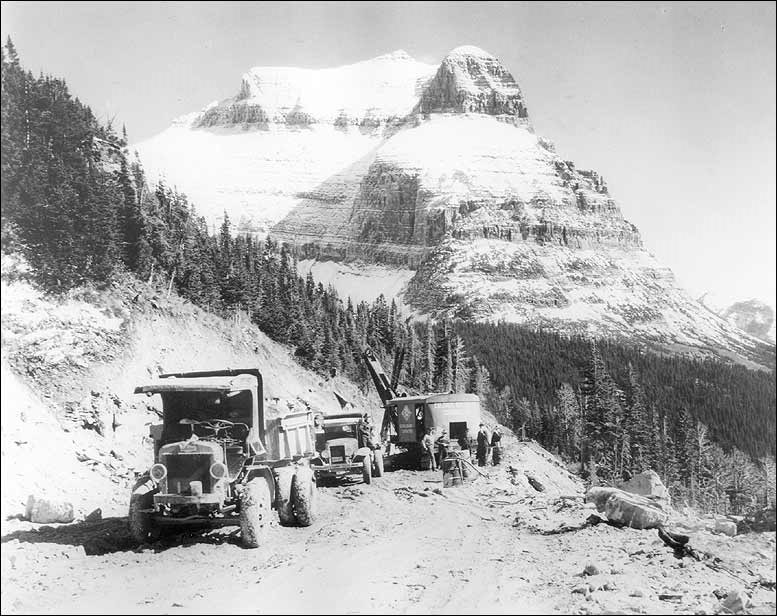
National Park Service photo.
The National Park Service wanted to ban the use of power shovels in building Going-to-the-Sun Road. Because most contractors refused even to bid on the job if they couldn't use their power equipment, and because the cost of a road built exclusively by hand labor was too great, the power equipment was allowed.
Questions for Photo 4
1. This photo shows two trucks and a gas shovel. It was difficult to get equipment like this up to these elevations without roads. Some of it was fitted with tractor treads, while some was disassembled and hauled in by horse-drawn sleds or pontoon barges. Why do you think contractors refused to work without this equipment even when it was so difficult to get it up to the construction site?
2. This photo appears to show the end of the completed part of the road. Where do you think the road will go next? What sort of work needs to be done?
3. After examining photos 1-4, what generalizations can you make about working and living conditions for workers building Going-to-the-Sun Road?
4. When Going-to-the-Sun Road was dedicated, Secretary of the Interior Harold Ickes wrote, "It is a magnificent job, perfectly accomplished. Workmen who risked their lives daily on the face of the steep cliffs that had to be conquered to make this modern trail, deserve special honor for their share in the great undertaking."¹ If you had been a worker on the project, would you have felt honored by the Secretary's statement?
¹ "Report of the Dedication of the Going-to-the-Sun Highway, July 15, 1933, Glacier National Park Montana." Typescript, Park Files, Glacier National Park.
Visual Evidence
Photo 5: View of the Garden Wall from Going-to-the-Sun Road.
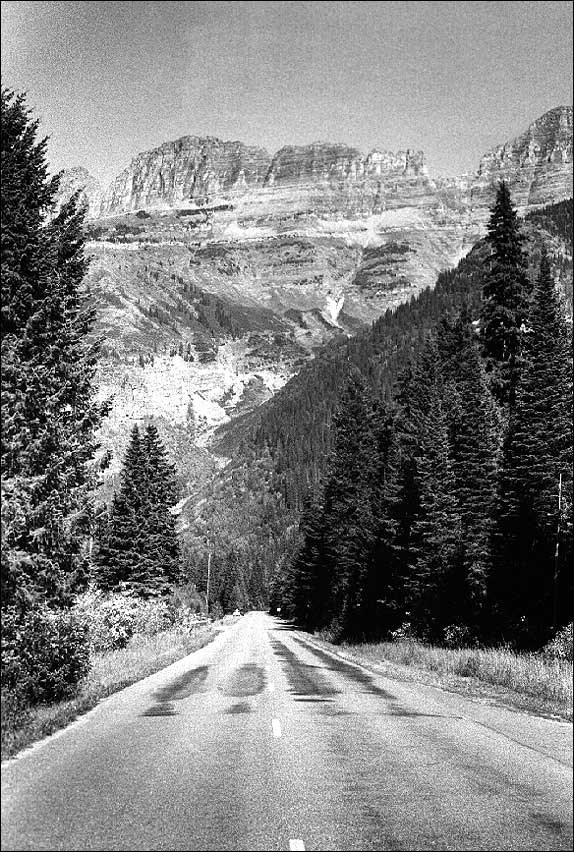
(National Park Service, Ethan Carr, photographer)
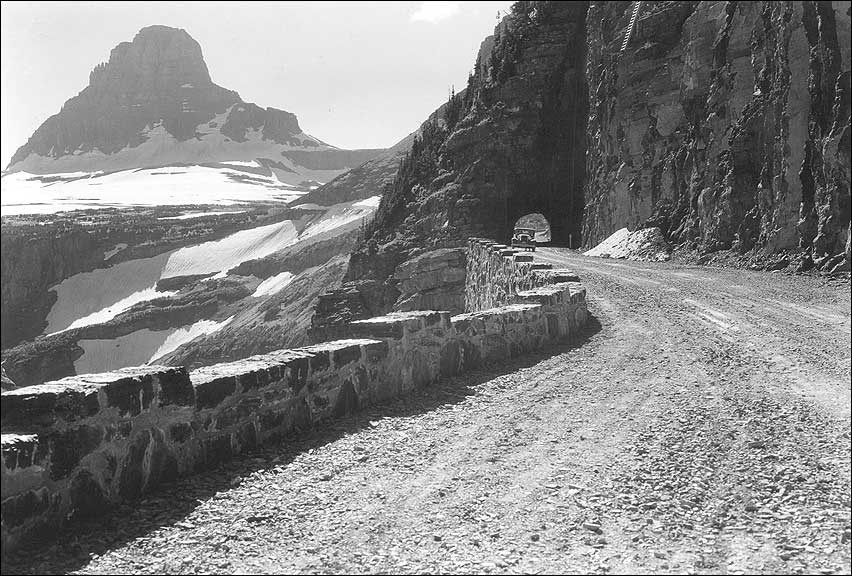
(National Park Service, George A. Grant, photographer)
Questions for Photos 5 and 6
1. Look carefully at Photo 5. Can you see the line of Going-to-the-Sun Road, ascending from left to right on the upper part of the mountainside? Do you think most people driving in the valley would be aware of the road above them? Do you think it was important to make the roadway so inconspicuous?
2. Photo 6 shows a portion of Going-to-the-Sun Road at about the time it opened. The roadbed is unpaved and about 22 feet wide. Use a measuring tape to draw out a 22 foot wide path on the floor of your classroom or on a playground. Do you think you would feel comfortable driving on a road that wide? Would you be aware of the steep drop-off on the other side of the retaining wall?
3. Visitation to Glacier National Park began to rise rapidly as soon as Going-to-the Sun Road was completed. Today approximately 600,000 cars drive the road every year, even though it is only open from early June to mid October. Do you think making it possible for visitors to see these views justifies the expense and the work that went into constructing the road? Why or why not?
Putting It All Together
The following activities will help students to understand some of the issues involved in the use of parks.
Activity 1: Use a Park or Preserve It?
Explain to students that planners of roads serving scenic parks, whether national or state, had to answer a basic question: How could the park provide both a "hands-on" and a "don't touch" experience for visitors? According to the Organic Act that created the National Park Service in 1916, the mission of the Park Service was "to promote and regulate the use of...national parks, monuments, and reservations...to conserve the scenery and the natural and historic objects and wildlife therein by such means as will leave them unimpaired for the enjoyment of future generations." States adopted similar criteria, but in most cases there have been conflicts and problems. Even when visitors are careful of the land, their sheer numbers may overwhelm the capacity of trails and campgrounds.
Divide the class into two groups. Group 1 represents those who would restrict the number of visitors allowed into the park in order to conserve the land as it is. Students in this group should consider what their position would be on building a road, for instance. Construction would damage the landscape, but might confine the largest number of visitors to specific areas of the park, protecting other areas against excessive visitation. Group 2 takes the position of those who believe that as Americans who pay taxes to support parks they have the right to use the facilities when and as they choose. Students in this group should consider what they would be willing to do to accommodate unlimited visitation--the cost and impact of constructing campgrounds and other accommodations, insuring safety and security, expanding existing roadways to be used by more cars and recreational vehicles. What would they do to ensure that what people came to see was not destroyed by the very people who came to see it?
Have each group develop and present at least three arguments for their assigned point of view. After both sets of arguments have been presented, ask all students to list the kinds of work that are needed to make a park more accessible and to accommodate visitors, and those that are needed to protect the park's natural resources from overuse or abuse. For example, to make a park more accessible, students should consider road construction and maintenance, operation of hotels and stores, trash collection, security, and police. For concerns about conservation, students might consider security people to enforce regulations and the use of biologists, geologists, and others to study and monitor the well-being of the park's natural resources. In either case, do students think we should count on visitors to protect parks voluntarily, or do we need specific regulations?
Activity 2: Working in a Park
Have students imagine that they are members of the work crew surveying or building Going-to-the-Sun Road (or another road through a favorite park). Using the reading by Frank Kittredge as a model, have them write a letter to a friend (real or imaginary) describing both the work they did on a typical day and the place where they did it. When the letters are completed, have students meet in groups of four and five to read their letters aloud. Have each group vote on which letter from their group should be read to the full class. Ask them to compare what they wrote with Kittredge's description. Debrief the exercise by discussing the problem of using hyperbolic language without becoming trite. Why does ordinary language tend to fail us when we try to describe extraordinary events or landscapes?
Activity 3: Investigating the Local Community
Explain to students that most people driving on Going-to-the-Sun Road are more aware of the scenery than they are of the road. Roads and highways in our own communities are also easy to take for granted. Have the students identify a road that they think is important to their community. Have them do some research on when it was built, why it was needed, who built it, why it is located where it is, how long it took to build, what difficulties complicated its construction, etc. Was there controversy about the road? Were older buildings or neighborhoods destroyed when the road was built? Much of this information may be found in old newspaper archives. Older citizens will probably remember recent road building projects and may be able to talk to students about what life was like before the road was built and how things have changed. Students may also be able to interview someone from the local highway department who can explain the road construction process to them and identify all the problems that have to be solved in building a road. Students may be able to visit a current nearby road-building project to see the type of work being done and how that work compares with the construction of the Going-to-the-Sun Road.
After they explore the subject, ask your students to use what they've learned and the information they've gathered to create a chart comparing and contrasting the creation of the local road with the creation of the Going-to-the-Sun road. They should consider the similar or different purposes, environmental concerns, costs, controversies, tools used for planning and construction -- as well as the methods and materials used during those stages -- and organizations that oversaw construction for both roads.
Going-to-the-Sun Road: A Model of Landscape Engineering--
Supplementary Resources
By working with Going-To-The-Sun Road: A Model of Landscape Engineering, students will learn about some of the practical problems of constructing roads in difficult terrain and about the added challenge of building in such a way as to enhance, rather than damage fragile and beautiful places. Those interested in learning more will find a variety of interesting materials on the Internet.
Glacier National Park
Glacier National Park is a unit of the National Park System. Visit the park's Web page to see images of the park's dramatic scenery, and to learn more about the park's history and about visiting the park.
World Heritage Site
In 1995, Waterton-Glacier International Peace Park was designated a world heritage site because it was the world's first International Peace Park. Situated on the border between Canada and the U.S., the park is exceptionally rich in plant and mammal species as well as prairie, forest, and alpine and glacial features. The World Heritage Site Web page provides more information and links to other related places worldwide.
Biosphere Reserve
Glacier National Park has been designated a Biosphere Reserve by UNESCO as an ecosystem promoting solutions to reconcile the conservation of biodiversity and sustainable use. Find out more about the biosphere reserve program on their Web page.
Library of Congress
Search the Library of Congress's American Memory web page for images and other information on early road building, the national parks, and conservation. The Historic American Buildings Survey/Historic American Engineering Record Collection contains information, photographs, and drawings of Going-to-the-Sun Road and other historic roads across the country. The Evolution of the Conservation Movement collection includes documentary and visual materials on the history of conservation in the United States from 1850 through 1920, including Congressional hearings that led up to the creation of the National Park Service in 1916.
American Society of Civil Engineers
Going-to-the-Sun Road was designated a Landmark of Civil Engineering in 1985. The ASCE Web page provides information on the road and on other important historical engineering projects.
For Further Reading
Students (or educators) wishing to conduct further research may want to refer to the following books: Warren Belasco, Americans on the Road: From Autocamp to Motel, 1910-1945 (Baltimore, MD: Johns Hopkins University Press, reprint edition, 1997); Ethan Carr, Wilderness by Design: Landscape Architecture and the National Park Service (University of Nebraska Press, 1999); Linda Flint McClelland, Building the National Parks: Historic Landscape Design and Construction (Baltimore: The Johns Hopkins University Press, 1998); and Paul S. Sutter, Driven Wild: How the Fight Against Automobiles Launched the Modern Wilderness Movement (University of Washington Press, 2002).
